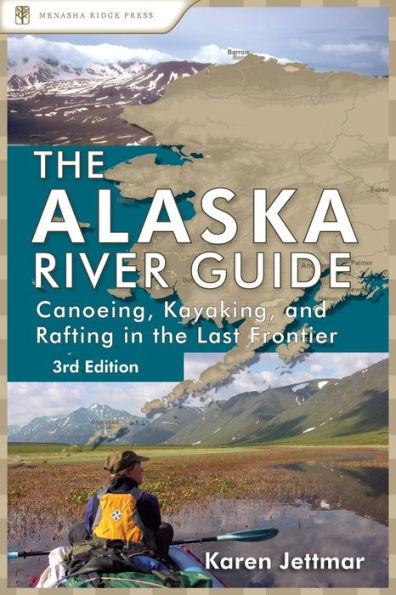Read an Excerpt
COLVILLE RIVER
The Colville is the largest river draining the Arctic Slope of the Brooks Range and is one of the most remote rivers in Alaska. It flows east out of the western end of the Brooks Range, then bends north to Harrison Bay on the Beaufort Sea 428 miles later, draining an area of 24,000 square miles.
For about 300 miles, the river traverses treeless arctic foothills and ridges. The lower river meanders over the treeless arctic coastal plain, a vast expanse of wet tundra, winding streams, and thousands of lakes, imparting a stunning sense of wide-open space. High cliffs along the river provide excellent habitat for raptors, and the Colville is one of the most productive peregrine falcon areas in Alaska. The lower Colville (the delta) continues to be a traditional fishing area for residents of Nuiqsut and Umiat.
The Colville area was originally inhabited by inland Nunamiut Eskimos, who lived in the Brooks Range along the upper reaches of the river and some of its tributaries, and Kuukpikmiut Eskimos, who inhabited the lower Colville. These groups hunted seal along the coast in spring or early summer and spent fall and winter either fishing or up in the mountains hunting.
Between 1850 and 1890, sweeping changes were triggered by the whaling industry. The Nunamiut unwittingly hastened the depletion of caribou as a food source by shooting caribou for the whalers. With subsistence resources dwindling, and alcohol and disease making destructive inroads, many people abandoned their migratory patterns and moved into coastal settlements. When commercial whaling faded, fur trapping, particularly for arctic fox, became an important economic activity for the Natives, and the federal government instituted reindeer herding to replace dwindling caribou populations. Trading posts sprang up all along the coast. With the discovery of oil in Prudhoe Bay in 1967, and the subsequent passing of the Alaska Native Claims Settlement Act, 27 Inupiat families left Barrow to lay claim to their ancestral hunting and fishing lands. Where the Colville River delta spreads out before flowing into the sea, they founded the settlement of Nuiqsut in 1973. Now encroaching industrialization on the North Slope threatens their traditional way of life.
Alpine oilfield lies just 8 miles from Nuiqsut. Developed in the late 1990s, and touted as state-of-the-art oilfield technology, its original footprint was to cover just 100 acres. A growing network of satellite fields expands the footprint exponentially, however, with the likelihood that Alpine will serve as the gateway for future oil development throughout the region.
The National Petroleum Reserve–Alaska, which encompasses the Colville River, is managed by the Bureau of Land Management. In the early 1920s, oil-stained sandstone was found in the foothills of the Brooks Range and along the arctic coast, and geologic, seismic, and drilling work was carried out between 1944 and 1953. The abandoned machinery, oil drums, and other detritus that littered the tundra around Umiat for decades seem nearly insignificant when compared to the massive industrial development under way on the Colville River Delta.
RATING: Class I–II. Upper 60 miles, in vicinity of Thunder and Storm Creeks, is Class I–II; all the rest is fast Class I. It is not a difficult river, but due to its extreme remoteness, only experienced wilderness travelers should make the run.
CAUTIONS: Upriver winds.
TRIP LENGTH: 375 miles between Thunder Creek and Nuiqsut; allow 19–20 days. About 250 miles between Kiligwa River and Umiat; allow 14–15 days.
SEASON: June–mid-August.
WATERCRAFT: Raft; canoe or kayak, preferably folding variety due to difficulty in transport of hard-shell boats. Use of a raft below Umiat is not advisable, due to upriver winds and tidal influence.
ACCESS: In—Scheduled airline to Deadhorse (Prudhoe Bay), Kotzebue, or Bettles. Scheduled airline to Deadhorse (Prudhoe Bay), Kotzebue, Nuiqsut, Bettles, or Coldfoot. It is possible to drive the Trans-Alaska Pipeline Haul Road (Dalton Highway) to Coldfoot, or even as far north as Happy Valley, and arrange for charter bush flights out of there. Charter wheelplane to gravel bars in vicinity of Thunder River or Kiligwa River. Floatplane charter to headwater lakes. Out—Take out at Umiat or continue on to Nuiqsut.
LAND MANAGER: National Petroleum Reserve (Bureau of Land Management, Fairbanks); private; state. (See Land Managers section at back of book for address and phone information.)
MAPS: Misheguk Mountain D-2, D-3; Utukok River A-1, A-2; Lookout Ridge A-4, A-5; Howard Pass D-1, D-2, D-3, D-4, D-5; Ikpikpuk River A-1, A-2, A-3, A-4, A-5; Killik River D-2, D-5; Umiat A-5, B-3, B-4, B-5, C-3, D-3; Harrison Bay A-2, A-3, B-1, B-2.
FISH: The Colville and its tributaries support a remarkable diversity of fish, considering its far north location. Twenty species may be found here, including arctic char, chum and pink salmon, lake trout, and arctic grayling. Fish are most prevalent in the mainstem and mouths of the Colville’s tributaries.
WILDLIFE: Caribou, grizzly bear, wolf, peregrine falcon, gyrfalcon, rough-legged hawk, golden eagle, yellow-billed loon.



